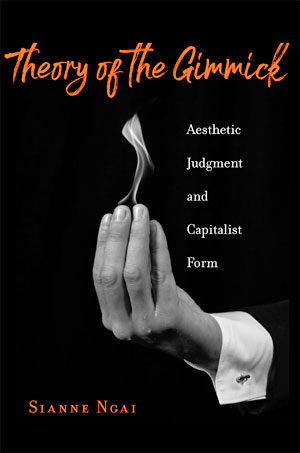
This book looks closely at an aesthetic form unique to capitalist society: the irritating and yet strangely compelling gimmick. It argues that the gimmick lies latent in every made thing in capitalism. The gimmick is an unconvincing aesthetic object that we tend to describe in specifically economic terms as cheap or overvalued. It can take the guise of an aging “special effect,” a questionable financial strategy, a supposedly time-saving kitchen gadget, or a foam served in a high-end restaurant—any device we regard as making dubious claims about value. It includes both the painstakingly devised and the gratuitously disposable. The gimmick is also an aesthetic judgment, or spontaneous, feeling-based evaluation. It is what we call things when we are uncertain if they are wonders or just tricks. Most crucially, the gimmick strikes us as working both too little and too hard.
In our encounter with the gimmick’s dissatisfying and yet still bizarrely attractive form, we are thus registering an uncertainty about labor, value, and time: the essential metrics of capitalism. These measurements become tellingly impossible to separate in a system compelling continuous technological innovations as capital moves around the world in search of profit, expelling labor from the lines it abandons and throwing entire populations out of work. Our ambivalent experience of the intrinsically overrated gimmick thus ultimately reflects doubt about where “value” is said to reside in capitalism—and about why wealth needs to be measured in this specific form in the first place.
I look at the gimmick from a variety of angles but mostly within the domain of culture or art, where ambiguities about value and labor have always come to the fore—and especially in our late capitalist present. I focus on works by artists who willingly take the risk of deploying the gimmick in efforts to represent and reflect on its compromised form. Tracking this form across a variety of objects—novels by Helen DeWitt, Nicola Barker, Thomas Mann, Henry James, and Mark Twain; horror films like It Follows, the photographs of Torbjørn Rødland, and the video art of Stan Douglas—we see how the gimmick sparks not only suspicion but comedy. Both point to deeper anxieties about capitalism as a whole.
Theory of the Gimmick continues the effort undertaken in my previous books, Our Aesthetic Categories (2012) and Ugly Feelings (2005) to get people to take “minor,” trivial, or everyday affective and aesthetic phenomena seriously. The aesthetic forms and judgments I analyze—from ambiguous evaluations like “interesting” to viscerally powerful experiences like cuteness—are specific to capitalism and inevitably compromised: based on mixed or clashing feelings, ideologically ambiguous, and lacking in moral prestige. But they tell us just as much—if not sometimes more—about the world, the way it appears to us, and our complex and historically changing relation to others, as do the philosophically prestigious concepts of the beautiful and sublime.
So my study of the gimmick carries on with a project undertaken in my other books. But it goes deeper, by focusing on “value” and the dynamics of its production and realization underlying the phenomena discussed in these other books. The valorization of commodities ultimately connects the processes of production, circulation, and consumption I discuss in Our Aesthetic Categories.
Some theorists of the contemporary like to proclaim Marx’s value theory obsolete, preferring to use concepts like “human capital” or “bare life” when speaking of how capitalism exploits people, including the many who are not laborers. But simply in being what it is, the gimmick proves that value-labor theory is alive and kicking in the ordinary ways in which people make aesthetic judgments, and thus share their aesthetic experiences with other people.
This is good, because value-labor theory—a theory of social domination based on how value becomes bound to time through the abstraction of labor—highlights and even enables the measurement of exploitation that basic economic forms like the wage and profit obscure. It is also a theory that takes the historical uniqueness of capitalism’s social forms seriously—and as forms which impact as much if not more on those kept or left outside the wage relationship as on those who are inside it.
Aesthetic theory and Marxist theory—in what I take to be its inseparable intersection with feminist social reproduction theory—are thus the main intellectual traditions I engage with.
The photographs by Torbjørn Rødland on pages 216-217 showcase a gimmick he often uses in his images: a hand entering from an invisible space outside but also entirely specific to and thus belonging to the picture—a space Eyal Peretz calls the “off”—to manipulate or toy with something inside its boundaries. I say a lot about this “handy” device, how it enables Rødland to introduce a surprising abstraction into his imagery, and why it reminds me of the white-gloved, disembodied hand of Hamburger Helper: a product originally designed to save American housewives time and effort in the preparation of family meals.
So here we have a classic gimmick: the labor-saving device. Represented by that other classic gimmick: the advertising icon. We find this recursivity in the original Helper jingle, which readers my age and older might remember: “Hamburger Helper / helped her hamburger / help her / make a great meal.” And so the gimmick assists in reinforcing the euphemism of the housewife as the performer of a personal service (“helper”)—as opposed to a reproductive laborer whose contribution to surplus-value is structurally concealed by the wage.
As a literature professor who thinks it is important to recover the work of brilliant but forgotten or little-known writers, I also hope that the reader turns to page 11. I have a short reading there of a zany novel published in 1966 by Charles Stevenson Wright, a queer experimental writer who has fallen outside the canons of both postwar American and African American literature. The Wig opens with the narrator’s explanation of how racism’s blockage of his ability to acquire a wage directly forces him to acquire a gimmick. This gimmick is the novel’s eponymous wig, or new way of styling the narrator’s hair—via a product called Silky Smooth—so he can appear non- or “less” Black to racist employers.
Wage, wig, and gimmick all slide together here in a provocative way that anticipates all of the major themes in my book—and that reminds us of how one cannot talk about capitalism without talking about racism. The Wig, which I think Wright wants us to imagine as almost just as easily titled The Wage, also highlights one of the most important contradictions involved in the valorization of commodities, which is the way in which capitalism links the necessary to the superfluous. That contradiction gets mirrored in the gimmick’s flagrantly unworthy form.
My broadest hope for this book is that readers living in different areas of the world will immediately recognize the aesthetically impoverished, yet oddly compelling and often funny capitalist form I am describing, even if the word “gimmick” doesn’t circulate in the language they speak.
Theory of the Gimmick is also a theory of aesthetic judgment: an ordinary but intersubjectively complex and often rhetorically creative speech act. My hope is that the book brings out this oddly underexamined “side” of aesthetic experience, which is the side that involves a verbal performance.
The gimmick is a fundamentally suspicious judgment, in which we categorically distinguish the false from the true by expressing doubt about “value” being where capitalist society purports it to be. Yet this public exercising of suspicion is often bound up with playfulness and humor, and the pleasures of sharing our aesthetic experiences with others in general.
Theory of the Gimmick thus tries to remind literary scholars, in particular, of how much critical processing of capitalism goes on in ordinary conversation—and in everyday aesthetic experiences. For, over the last decade in this discipline there has been an unrelenting effort to convince people that “aesthetic experience” and “critique” are somehow opposed, and that “critique” is a humorless and fundamentally elitist activity.


Sianne Ngai is Professor of English at the University of Chicago. She is the author of Ugly Feelings (2005) and Our Aesthetic Categories: Zany, Cute, Interesting (2012), which won the Modern Language Association’s James Russell Lowell Prize, as well as Theory of the Gimmick, which is featured in her Rorotoko interview. Her work has been translated into multiple languages, and she has received fellowships from the Institute of Advanced Study in Berlin and the American Council of Learned Societies.